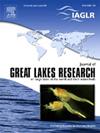Phytoplankton trends in the Laurentian Great Lakes (2001–2021) reveal significant changes in phytoplankton abundance and taxonomic composition
IF 2.4
3区 环境科学与生态学
Q3 ENVIRONMENTAL SCIENCES
引用次数: 0
Abstract
We present Laurentian Great Lakes phytoplankton trends from 2001 to 2021 in spring and summer. Trend analysis identified significant changes in phytoplankton abundance and taxonomic composition. This included the loss of phytoplankton biovolume, especially diatoms, in lakes Huron and Michigan following the quagga mussel invasion, an increase in cyanobacteria especially in the central basin of Lake Erie, and an increase in phytoplankton biovolume in Lake Superior. Within functional groups, we observed increases in the absolute and relative abundances of flagellated organisms, largely owing to increases in single-celled cryptophytes and dinoflagellates in the spring and colonial chrysophytes in the summer, and a rise in lightly silicified rhizosolenoid diatoms during summer. Random forest analysis identified potential drivers and mechanisms for phytoplankton changes alongside concurrently sampled invertebrate and water quality parameters. The quagga mussel invasion was an important driver of major phytoplankton shifts, but climate change-related stressors affecting stratification are also likely drivers of changes. We observed strong relationships between phytoplankton and microzooplankton, with rotifers and copepod nauplii showing positive relationships with many phytoplankton groups, though whether these are top-down or bottom-up associations is not clear. This study recognizes continuing reorganization of the Great Lakes phytoplankton community that is likely to have long-term impacts on food webs.
劳伦森五大湖浮游植物趋势(2001-2021)揭示了浮游植物丰度和分类组成的显著变化
我们展示了2001年至2021年劳伦森五大湖春季和夏季浮游植物的趋势。趋势分析表明,浮游植物丰度和分类组成发生了显著变化。这包括休伦湖和密歇根湖浮游植物生物量的减少,尤其是硅藻,尤其是在斑草贻贝入侵之后,蓝藻的增加,尤其是在伊利湖中央盆地,以及苏必利尔湖浮游植物生物量的增加。在官能团中,我们观察到鞭毛生物的绝对丰度和相对丰度增加,主要是由于春季单细胞隐藻和鞭毛藻增加,夏季群体苔藓增加,夏季轻度硅化根螺线管硅藻增加。随机森林分析确定了浮游植物变化的潜在驱动因素和机制,以及同时采样的无脊椎动物和水质参数。斑驴贻贝入侵是主要浮游植物迁移的重要驱动因素,但影响分层的气候变化相关压力因素也可能是变化的驱动因素。我们观察到浮游植物和微型浮游动物之间的密切关系,轮虫和鹦鹉桡足类与许多浮游植物类群表现出积极的关系,尽管这些关系是自上而下还是自下而上的联系尚不清楚。这项研究认识到五大湖浮游植物群落的持续重组可能对食物网产生长期影响。
本文章由计算机程序翻译,如有差异,请以英文原文为准。
求助全文
约1分钟内获得全文
求助全文
来源期刊

Journal of Great Lakes Research
生物-海洋与淡水生物学
CiteScore
5.10
自引率
13.60%
发文量
178
审稿时长
6 months
期刊介绍:
Published six times per year, the Journal of Great Lakes Research is multidisciplinary in its coverage, publishing manuscripts on a wide range of theoretical and applied topics in the natural science fields of biology, chemistry, physics, geology, as well as social sciences of the large lakes of the world and their watersheds. Large lakes generally are considered as those lakes which have a mean surface area of >500 km2 (see Herdendorf, C.E. 1982. Large lakes of the world. J. Great Lakes Res. 8:379-412, for examples), although smaller lakes may be considered, especially if they are very deep. We also welcome contributions on saline lakes and research on estuarine waters where the results have application to large lakes.
 求助内容:
求助内容: 应助结果提醒方式:
应助结果提醒方式:


